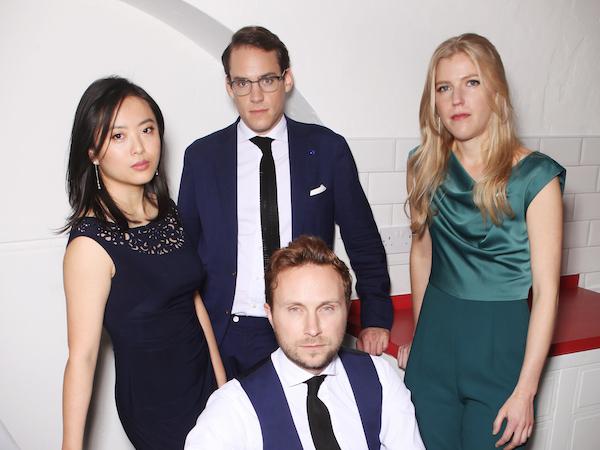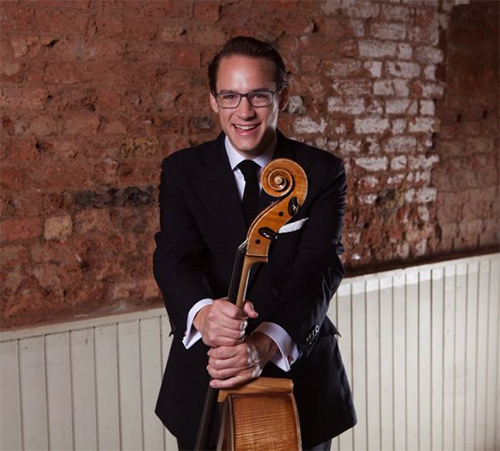by Mike Telin

“Alex Redington and myself are the two founding members,” he said. “We’ve known each other since we were nine years old. We met at a chamber music camp for kids in the U.K. — we used to go during the school holidays. Then, when we were fifteen or sixteen we were put into the quartet that we are still in today. It just really worked, so we kept going. There never was a moment where it was a decision to try and make it professionally — it just took us and we’ve always been doing it. It’s our life I suppose.” In 2018 the Quartet celebrated their twentieth anniversary.
On Friday, February 22 at 7:30 pm in Finney Chapel, the Doric String Quartet (Alex Redington and Ying Xue, violins, Hélène Clément, viola, and John Myerscough, cello) will make their Northeast Ohio debut with a concert on the Oberlin Artist Recital Series. Tickets are available online. Beginning at 9:30 am on Saturday, February 23 in the Conservatory, the Doric will give four master classes — each member will work with at least one student chamber music ensemble.
Myerscough said that with all of the “extraordinary repertoire” that has been written for the string quartet, it is easy to find the “encouragement” to keep going. “You can get addicted to playing all these amazing pieces that we have.” Friday’s concert will feature works by Haydn, Britten, and Mendelssohn.
The cellist referred to their program as a “snapshot of delights.” He added that they often begin their programs with the music of Haydn, a composer he said is a “big feature” in their lives. “We like to do something meaty on the second half, and have something a bit more contemporary or different in the middle. And this program is no exception.”
The Doric will open with Haydn’s rarely heard Quartet in B-flat, Op. 33, No. 4. “This is an extraordinary piece,” Myerscough said. “The Opus 33’s did mark a new beginning in his quartet compositions, but No. 4 is bizarre. It starts with a closing gesture, so the whole of the first movement he’s trying to work out how to complete a movement that’s almost completed before it begins. It’s incredibly brainy, but brilliant at the same time. The minuet and trio is very short, and the slow movement is almost slightly religious, kind of ‘pure’ music. The last is probably one of the most ridiculous movements that Haydn ever wrote — it’s really silly. I almost never see this on a concert program.”
Myerscough described Mendelssohn’s Quartet No. 4 in e, Op. 44, No. 2 as a “fantastic” work that is full of the composer’s compositional trademarks. “He always writes amazing scherzos, and this one will not disappoint. The first is marked ‘allegro appassionato,’ and it does feel like nonstop passion. There’s a lot of depth in it, a lot more than just angst and anguish. As always with Mendelssohn, it sounds so simple and perfect but what’s going on under the surface is incredibly complicated.”
The middle portion of the program is dedicated to a work Myerscough called “one of the masterpieces of the twentieth century,” Britten’s Quartet No. 3 in G, Op. 94. “It’s the last piece that he completed, and there’s a sense that he has pared down the way that he writes for the string quartet. The textures are often very bare — quite often only one or two people playing, so there’s a great amount of emptiness and simplicity. But you feel that despite that, there’s depth and truth in the music. There is a feeling that Britten was aware of his own death, particularly in the last movement. After some quotes from his opera Death in Venice, it moves into a passacaglia section and there’s a sense that we are treading onward to a different place.”
The Doric have recently finished recording all of Britten’s quartets, scheduled for release on the Chandos label in April. “We recorded them in Snape Maltings, the concert hall he had built for the Aldeburgh Festival, and where the Third Quartet was premiered just after his death. Making the recording was an intense and emotional experience — we feel very close to his music.”
At Oberlin, the Doric will be using “Classical” bows by Luis Emilio Rodriguez Carrington during the Haydn and Mendelssohn. (Click here to view a short video where the Quartet discusses the bows’ advantages — and the advantages of wearing slippers during rehearsals.)
Myerscough said that using the bows gives them more flexibility and freedom to “investigate” contrasts in the music as well as the ability to make quick changes in articulation and stroke. “I find that everything is a little more rounded with the normal bow. The Classical bows enable clarity of texture and wonderful, on-the-string fast strokes — you can get the brilliance of a bouncy stroke but with substance and depth.”

Another special something about the bows: the ivory comes from woolly mammoths. “The string instrument world is now completely against the use of elephant ivory, but you can get quite a bit of woolly mammoth ivory from Siberia. It’s all buried in the permafrost, and they dig it up in the riverbanks. It’s quite a nice touch that it’s 30,000 years old.”
In 2018, the Quartet became Artistic Directors of the Mendelssohn on Mull Festival, where they are charged with providing young professionals in the field of string chamber music with a week of intensive mentoring, coaching, and development. “It’s incredibly exciting to be able to be on the other side. Realistically, we’re all studying until we stop — that’s the nature of music — but it helps us connect with young talented players, because it’s less about us picking people and teaching them, and more about an exchange of ideas.”
During the Festival, each member of the Doric plays in a chamber group, which the cellist said inspires learning in an open environment. “That’s one of the things that is a feature of our group — we try to have an open and positive rehearsal and creative atmosphere. There’s no one person dominating. We don’t have arguments or mass disagreements. We respect each other and trust each other, and try to pass that attitude and approach down to the younger people so they don’t come into a rehearsal and just have lots of unnecessary arguments because their egos get too big. We try to create an enjoyable and inspiring atmosphere, and I think we managed to do that last year.”
The Doric also serve on the faculty at London’s Royal Academy of Music. “Teaching is becoming a bigger and bigger part of our life but we all love it.”
And back to slippers — Myerscough gave a hearty laugh when I asked him if he makes his students wear them. “I haven’t insisted on that just yet, but they should be inspired by them. I definitely like playing the cello in my slippers — I’m wearing them right now.”
Published on ClevelandClassical.com February 11, 2019.
Click here for a printable copy of this article



